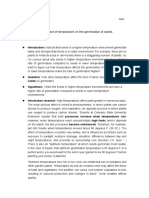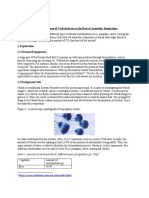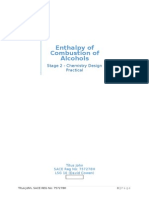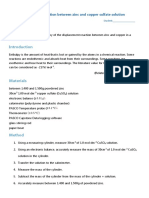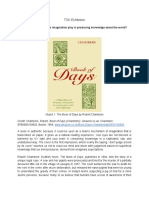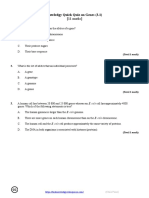Biology IA
Biology IA
Uploaded by
PineappleHeadCopyright:
Available Formats
Biology IA
Biology IA
Uploaded by
PineappleHeadOriginal Description:
Copyright
Available Formats
Share this document
Did you find this document useful?
Is this content inappropriate?
Copyright:
Available Formats
Biology IA
Biology IA
Uploaded by
PineappleHeadCopyright:
Available Formats
Biology IA
Fatimah
7th November 2016
Research Question
What is the effect of temperature on the enzyme Rennin
Variables:
Independent
Dependent
Controlled
Variable Measured
Temperature of water
bath
Rate of Reaction
(kPa/Minute)
Method to Control
10C, 22C, 30C, 37C,
45C
Average time it takes for
milk to curdle. Measured
using stopwatch
Amount of milk
Amount of Enzyme
(rennin)
Time (min)
Temperature throughout
the trial
Size/Volume of the test
tubes
Type of milk
Method:
-
Prepare four water baths by half-filling Styrofoam cups with different
amounts of tap water, hot water and ice to give each one a different
temperature: 20C, 30C, 40C and 50C. Label each cup with its
temperature.
Add 3mL of milk to each of 8 test tubes using a pipette. Label 4 test tubes
A and B
Place one A test tube and one B test tube into each of the water baths,
and leave for 5
10 minutes to allow the contents of both tubes to come to the
temperature of the water bath.
While you are waiting, crush a junket tablet in 10mL of water in a small
beaker. Ensure the junket and water are fully mixed before doing the next
step.
After the test tubes have reached the required temperature, add 5 drops
of junket solution to each of
the test tubes labelled A. Shake each tube to mix the contents, and
replace in the water bath.
Record the time when the rennin (i.e. junket solution) was added in each
case.
Examine the tubes each minute for 20 minutes by tilting them gently,
but not shaking them
Record the time taken for the contents of each tube to clot, and enter it in
the results table. If any tubes show no clotting in the 20 minutes allowed,
record a negative sign in the table.
You might also like
- Example IB Biology IADocument16 pagesExample IB Biology IAIB Screwed93% (153)
- Biology IaDocument9 pagesBiology IaErika ChenNo ratings yet
- Ib Chem IaDocument9 pagesIb Chem IaFrank Lala0% (1)
- Purple TopshellsDocument17 pagesPurple Topshells06odouglasNo ratings yet
- Determination of KC For An Esterification Reaction ReportDocument5 pagesDetermination of KC For An Esterification Reaction ReportTuo Hundou Lee100% (3)
- IB Biology Lab ReportDocument21 pagesIB Biology Lab ReportAgnieszka100% (2)
- Biology IADocument16 pagesBiology IAAngelina TomacNo ratings yet
- Biology IA Newdraft!Document16 pagesBiology IA Newdraft!Katherine100% (1)
- Biology IA GuidelineDocument5 pagesBiology IA GuidelineEmilyChung50% (2)
- Effect of Temperature On RespirationDocument19 pagesEffect of Temperature On RespirationLiza KhanNo ratings yet
- IB Bio IADocument16 pagesIB Bio IAjunyiwuNo ratings yet
- Enzyme Investigation (IA)Document10 pagesEnzyme Investigation (IA)Massimo WuNo ratings yet
- Gr. 12 - Biology Lab ENZYME LACTASEDocument5 pagesGr. 12 - Biology Lab ENZYME LACTASEwhimsicalkevinNo ratings yet
- The Effect of Temperature On The Rate of Reaction of YeastDocument8 pagesThe Effect of Temperature On The Rate of Reaction of YeastMatt BeaumontNo ratings yet
- Investigating Energy in Food: Research QuestionDocument3 pagesInvestigating Energy in Food: Research QuestionChloe TamNo ratings yet
- Milk and Rennin PracDocument7 pagesMilk and Rennin PracTherese Nguyen50% (2)
- IB Bio IA On Nuruk FermentationDocument9 pagesIB Bio IA On Nuruk FermentationGoeun Jeong (yr. 18-20)No ratings yet
- Titus John - Enthalpy Prac ReportDocument12 pagesTitus John - Enthalpy Prac Reportapi-295071132No ratings yet
- Beetroot Core Practical Writing FrameDocument5 pagesBeetroot Core Practical Writing FrameJett0% (1)
- 4 - IB Biology Required Practical 4 - Chromatography - IBDP - Lab Experiment GuideDocument5 pages4 - IB Biology Required Practical 4 - Chromatography - IBDP - Lab Experiment GuidemelindahofmannNo ratings yet
- Biology IaDocument4 pagesBiology IaIndrani Goswami100% (1)
- WM Chemistry Ia Final Risma RemsudeenDocument12 pagesWM Chemistry Ia Final Risma RemsudeenPriyanshi PeelwanNo ratings yet
- The Effect of Sugars On The Respiration by YeastDocument2 pagesThe Effect of Sugars On The Respiration by Yeast8851403560% (1)
- Lab: Enthalpy of The Reaction Between Zinc and Copper Sulfate SolutionDocument2 pagesLab: Enthalpy of The Reaction Between Zinc and Copper Sulfate Solutionsameera beharryNo ratings yet
- Bio IA TaskDocument12 pagesBio IA TaskWen Wen Teh100% (2)
- Cellular Respiration in YeastDocument11 pagesCellular Respiration in YeastxshelyNo ratings yet
- Biology IA FinalDocument16 pagesBiology IA Finalneesha.joshi12345No ratings yet
- Chem HL Ia Jbb156Document12 pagesChem HL Ia Jbb156Ishita AgarwalNo ratings yet
- Fundamentals of Paper 3 Biology SPMDocument20 pagesFundamentals of Paper 3 Biology SPMVei KeithNo ratings yet
- Biology IA ReportDocument20 pagesBiology IA Reportkethanacc2No ratings yet
- Biology Extended Essay Madeeha Kalsekar: (I) State A Null Hypothesis That The Student Could Make For This InvestigationDocument6 pagesBiology Extended Essay Madeeha Kalsekar: (I) State A Null Hypothesis That The Student Could Make For This InvestigationMadeeha KalsekarNo ratings yet
- WM Final Chemistry Ia Watermark 1Document12 pagesWM Final Chemistry Ia Watermark 1ppNo ratings yet
- Biology New IADocument3 pagesBiology New IAyokuso100% (2)
- Chromatography Worksheet - (C) 2002 Ian Guch - All RightsDocument2 pagesChromatography Worksheet - (C) 2002 Ian Guch - All RightsJulian Alberti100% (1)
- IA Practical WDocument8 pagesIA Practical Wchloe.paleoNo ratings yet
- Biology Laboratory Report Enzyme Concentration and Rate of ReactionDocument11 pagesBiology Laboratory Report Enzyme Concentration and Rate of ReactionTaslim Haji MunshiNo ratings yet
- SL Chemistry Ia 4Document12 pagesSL Chemistry Ia 4api-37363504650% (2)
- Core Practical 5 and 6Document4 pagesCore Practical 5 and 6Adam EchikrNo ratings yet
- Biology IADocument15 pagesBiology IARNo ratings yet
- Biology Extended Essay Draft 1Document8 pagesBiology Extended Essay Draft 1Sarah Al ObaidanNo ratings yet
- EE Biology - Sample A (High)Document31 pagesEE Biology - Sample A (High)Merve ÖzkayaNo ratings yet
- IB Biology Intro To Statistics PropertiesofWaterLab-1Document5 pagesIB Biology Intro To Statistics PropertiesofWaterLab-1DALE WOLFFNo ratings yet
- Preparing Ozone Test Strips (Aka Schoenbein Papers)Document7 pagesPreparing Ozone Test Strips (Aka Schoenbein Papers)Old McDonaldNo ratings yet
- Top 22 Biology Internal AssessmentDocument1 pageTop 22 Biology Internal AssessmentNatasha BaranovaNo ratings yet
- Finding Percentage of Calcium Carbonate in EggshellDocument8 pagesFinding Percentage of Calcium Carbonate in EggshellAndrew LeNo ratings yet
- 2.2 Enzyme Concentration Core Practical Writing FrameDocument4 pages2.2 Enzyme Concentration Core Practical Writing FramepaligoddNo ratings yet
- Abla Alioui Tok Exhibition Final FinalDocument6 pagesAbla Alioui Tok Exhibition Final Finalapi-543376640No ratings yet
- Bio IA TopsDocument4 pagesBio IA TopsSanjana KumarNo ratings yet
- Biology IADocument11 pagesBiology IATijana TosicNo ratings yet
- Bio IADocument2 pagesBio IAbebelavida100% (1)
- Ib Bio Questions Digestion WansDocument19 pagesIb Bio Questions Digestion WansShreya DasNo ratings yet
- Gas Exchange Structured Questions IBDocument9 pagesGas Exchange Structured Questions IBJohn Osborne100% (1)
- Biology IADocument13 pagesBiology IAMilla Ramnebro100% (1)
- Chem IA 3 Hess' LawDocument8 pagesChem IA 3 Hess' LawSimone Lund SøegaardNo ratings yet
- IB Biology StatisticsDocument11 pagesIB Biology StatisticsChanan100% (1)
- Enthalpy of Combustion Updates2015Document5 pagesEnthalpy of Combustion Updates2015ysuzuki16No ratings yet
- Mesocosms Lab ReportDocument15 pagesMesocosms Lab ReportDiego A Beltran PNo ratings yet
- The Effects of Changing Temperature ExperimentDocument3 pagesThe Effects of Changing Temperature ExperimentapekshyaNo ratings yet
- Meat Free KetoDocument73 pagesMeat Free KetoPineappleHeadNo ratings yet
- Arabic Ab InitioDocument9 pagesArabic Ab InitioPineappleHeadNo ratings yet
- Bilingualism and IntelligenceDocument3 pagesBilingualism and IntelligencePineappleHeadNo ratings yet
- Bioknowledgy Quick Quiz On Chromosomes (3.2) : (7 Marks)Document3 pagesBioknowledgy Quick Quiz On Chromosomes (3.2) : (7 Marks)PineappleHeadNo ratings yet
- BioK QQ 3.1 QPDocument2 pagesBioK QQ 3.1 QPPineappleHead100% (1)
- Bioknowledgy Quick Quiz On 3.5 Genetic Modification and BiotechnologyDocument5 pagesBioknowledgy Quick Quiz On 3.5 Genetic Modification and BiotechnologyPineappleHeadNo ratings yet
- Bioknowledgy Quick Quiz On 3.3 Meiosis: (21 Marks)Document2 pagesBioknowledgy Quick Quiz On 3.3 Meiosis: (21 Marks)PineappleHeadNo ratings yet
- Personal Statement DraftDocument1 pagePersonal Statement DraftPineappleHeadNo ratings yet
- All Genetics FRsDocument11 pagesAll Genetics FRsPineappleHeadNo ratings yet
- All Genetics FRsDocument11 pagesAll Genetics FRsPineappleHeadNo ratings yet
- Up To Two Additional Marks Are Available For The Construction of Your AnswersDocument2 pagesUp To Two Additional Marks Are Available For The Construction of Your AnswersPineappleHeadNo ratings yet










